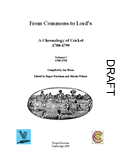Other Roger Heavens publications
An Index to Ayres' Cricket Companion
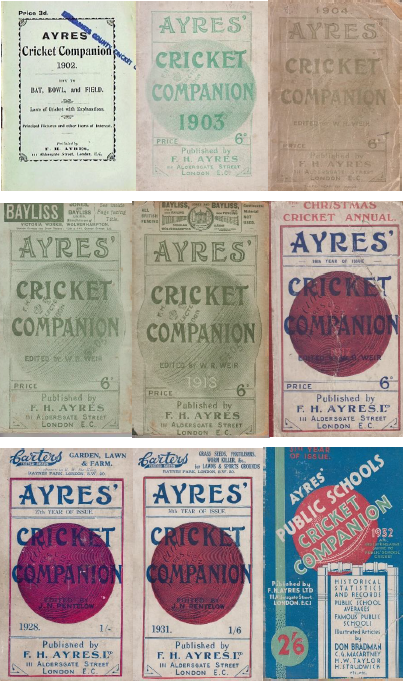 Price: £10 including postage and packing
Price: £10 including postage and packing
This important work (Padwick 1035 and 1343) was published by FH Ayres for 31 years (1902 till 1932) and as a source has often been neglected by many cricket historians. They contain a wealth of information particularly about the public schools, where there are many detailed historical accounts, but its main focus concerns biographical information. There are nearly 700 references ranging from one liners to biographies covering several pages together with hundreds of photographs of not just the subjects but also team photographs of many elevens. For example, one of the Hurstpierpoint elevens shown in the 1920s was completely unknown to the archivist at the college. With many essays by such luminaries as FS Ashley-Cooper, JN Pentelow, C Plairre (The Picknicker for his poems), and WR Weir (WR Wright) this index will encourage many to start collecting (or perhaps completing their sets) these valuable volumes.
The index is 80 pages long with many coloured illustrations, and although not a limited edition, only 50 copies have been printed.
See also an article to be published in The Journal of Cricket Society - FH Ayres and his Cricket Companion - view article here.
From Commons to Lord's - AWARD WINNER
Award winner:
Ian Maun has been recognised as the Association’s Statistician and Historian of the Year following the publication during 2009 of the first volume of his series on cricket in the 18th century. Ian’s work “From Commons to Lord’s” - published by fellow ACS member Roger Heavens - was long-listed by The Cricket Society for it’s Book of the Year Award, having been regarded as one of the most important cricket history books of recent years.
Ian, who worked in the Education Department at Exeter University, has meticulously unearthed many new details about cricket in the 18th century, having consulted newspapers, journals, letters and other documents housed in national and provincial collections, as well as other resources not previously consulted by cricket historians, including dictionaries, novels, plays and poems.
Ian’s research began many years ago when he tried to understand the relationship of the Hambledon Club’s exploits to the cricket which had preceded the days of the illustrious Club. What started out as a series of rough notes and jottings, trying to disentangle what was fact and what was fiction, metamorphosed into a research project and reference book which provides a sharper and more complete picture of 18th century cricket than previously achieved by many previous writers, as well as some of the great scholars of cricket history.
View photograph of Ian Maun with ACS President MJK Smith (Picture by Jenny Heald)
Author's introduction:
This Chronology originated in my desire to understand the relationship of the Hambledon Club’s exploits to the cricket which had preceded those illustrious days. What began as a few pages of notes quickly expanded into something much greater which took on a life of its own.
This is, then, a work covering the years 1700-1799. The choice of the end points is psychological rather than chronological. To my mind, the eighteenth century is represented by those years which began with the magical figures 17.. . It is a period of tricorn hats, curved bats, two-stump wickets and, later, early straight bats and three stumps to the wicket. The year 1700, while still technically in the seventeenth century, has been promoted to the glory era of the eighteenth! The year 1800 is a barrier, a hurdle beyond which lie top hats, spotted shirts, tall, narrow wickets, and other strange innovations. In order to remove such spectres, therefore, the year 1800, while still technically in the eighteenth century, has been banished to the nineteenth. The period 1700-1799 thus remains consistent in its prefixes, its precedents and its prejudices.
Such a work as this cannot be original. Far too many serious scholars have trodden this path before me, and this work draws heavily on the Herculean efforts of the Greats. Ashley-Cooper, Bentley, Buckley, Epps, Haygarth, H.P.-T. (P.F.Thomas) and Waghorn are but some of the authors whose earlier researches have been used to create a single account of Cricket as it is known between the chosen dates. None of these authors by himself gives a complete picture of the Noble Game. Some are limited by the very dates that they have chosen to cover, others by omissions from a broader canvas and still others by an exclusive concentration on a single club, village or county. The present work aims to present a fuller picture than that presented by these serious scholars of the game.
To fulfil this aim it has been necessary to examine the work of, inter alia, those mentioned above, particularly those whose researches in newspaper archives culminated in chronologies such as Cricket Scores 1730-1773 and The Dawn of Cricket (H.T. Waghorn) and Fresh Light on 18th-Century Cricket and Fresh Light on Pre-Victorian Cricket (G.B. Buckley). Nobody without a life-time of cricket research still ahead of them could cover the ground visited by these researchers who devoted years of their lives to combing newspaper files in museums and archives. In addition to revisiting these works and using them as a foundation, the works of other authors have been examined, e.g. Arthur Haygarth (Scores and Biographies), Frederick Ashley-Cooper (Cricket 1742-1751, inter alia), and Tim McCann (Sussex Cricket in the Eighteenth Century). To these authors, both living and dead, I owe a debt of gratitude which can never truly be paid.
Lest it be thought that this work is merely a reworking of other writers’ contributions, two things must be pointed out. Firstly, there are many errors and omissions in the work of the cited authors, and, where possible, these errors and omissions have been corrected or filled through a careful comparison and contrasting of the various sources available. Secondly, where possible, original research has been undertaken, notably in the MCC Library, the National Archives, at the Artillery Ground and in the files of various newspapers held in museums, libraries and archives. Furthermore, extensive work has been undertaken, using both physical and virtual resources, to investigate the period. Large numbers of new references from newspapers have been discovered. History books, journals, magazines, dictionaries, novels, plays and poems contain vast numbers of references to cricket, and these have, as far as possible been incorporated into the text.
The works consulted are acknowledged after each entry by a code whose key follows this introduction. Where more than one author lists the same event, the relevant works are cited. Where there is a disagreement in dates or there is uncertainty about events, these points are noted in the text. Where possible a solution or suggestion is offered. I make no claim to the absolute rectitude of such adjudications, and my findings are open to interpretation and correction. Indeed, it is hoped that readers who are in possession of greater or more accurate information will pass it on, so that subsequent editions may be corrected and supplementary information added. It is proposed that after this first edition, a Supplement be issued, and that this Supplement should eventually be incorporated into a second edition.
Where exact dates are known, these are given. Where an approximate date is known, the date is preceded by an asterisk. Matches on a single date precede those that began on that date but continued over two or more days. Where only the month is known, these matches/events normally follow more precisely dated matches/events in that month, unless there is possible evidence to the contrary. Following the list of events for each year is a short list of books and other publications which appeared in that year. This in turn is followed by a list of paintings and other illustrations which appeared in that year. No claim is made to completeness or exclusivity in these latter lists.
I should like to thank those who have assisted in this production, either through their own knowledge and enthusiasm, or in supplying information and publications which would otherwise have been inaccessible. In particular, Martin Wilson whose friendship, contributions and quiet enthusiasm for the period and this project have been of invaluable assistance; His Grace The Duke of Richmond and Gordon for kindly agreeing to write the Foreword; Ashley Mote, whose books started me on this trail; Roger Heavens and Christopher Saunders for their expertise and bookmanship; Roger Packham, who took up the challenge of editing the work; Andrew Hignell, Tim McCann and Willie Sugg, all experts on their counties; Guy Curry for his support and for the George Booth Diaries; John Goulstone for some early advice, Peter Wynne-Thomas at Trent Bridge for his enthusiasm and Glenys Williams, Adam Chadwick, Neil Robinson and Ken Daldrey at Lord’s for their untiring help in response to requests for obscure pieces of information. To others who contacted me to impart occasional pieces of information I extend my warmest thanks.
Teignmouth
Devonshire
2009
A History of The Horsham County Cricket Festival, 1908-2007
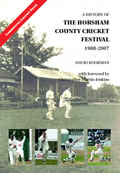 £ 10.00
£ 10.00In Edwardian Horsham a man had a dream. Arthur Oddie’s vision was to bring county cricket to the small market town. His powers of persuasion eventually prevailed and in June 1908 KS Ranjitsinhji led a Sussex side onto the field at Horsham for the first time in over 50 years.
The subsequent relationship between town and county has not always been an easy one. In 1911 the town told the county it couldn’t come because of a nearby agricultural show. In 1956 Sussex CCC stripped the town of its Festival, a decision that caused much bitterness. Almost 30 years were to pass before the ground at Cricket Field Road next staged Championship cricket. With the contraction and evolution of the modern game the long term future of the Horsham Festival must remain uncertain. Yet the much loved ground has witnessed some mighty deeds and played host to some of the greatest names in world cricket.
At its zenith between the wars the Festival was about so much more than just cricket. The town was en fête – and proud to be so – to a degree that can scarcely be imagined today. There were amateur dramatics and carnivals, County balls for the upper classes with humbler dances and whist drives for lesser folk. This book seeks to set the cricket in this wider social context and includes a fascinating look at some rare unpublished material relating to the 19th century development of Horsham Cricket Club itself.
Here then, to commemorate its Centenary, is the colourful history of the Horsham Cricket Festival.
Review: ACS Journal, Richard Lawrence:
“I have to confess that I approached this book with a little trepidation. Club and festival histories can all too easily slip into a season-by-season formula of matches and scores, and quickly become tedious for the reader. I need not have worried...”
Download the full review (PDF)
GB Buckley’s Fresh Light on 18th Century Cricket and Fresh Light on pre-Victorian Cricket (NINE PAIRS LEFT)
Two of the most important reference books of primary sources were written by George Bent Buckley but they are now very difficult to obtain. Although written relatively recently anybody researching early cricket, whether it be at club, county or national level, should consult these books. They contain information on a par with both HT Waghorn’s The Dawn of Cricket and Scores and Biographies Volume I and no cricket library should be without copies.
These hardback limited editions of 100 numbered copies with dust wrappers are £50 each plus £4 postage and packing. The earlier volume contains a four-page supplement. Should you want to purchase both volumes they will be sent for £100 post free.
The four page supplement is also available separately for any collector for £10 post free. This is basically a reproduction of the list of abbreviations to the front of the book but is useful when carrying out research.
GB Buckley’s Fresh Light on 18th Century Cricket
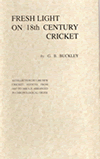 Price: £25
Price: £25A collection of 1000 new cricket notices from 1697 to 1800 arranged in chronological order. Birmingham 1935 261 pp. (Padwick 801)
GB Buckley’s Fresh Light on pre-Victorian Cricket
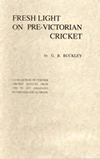 Price: £25
Price: £25A collection of new cricket notices from 1709 to 1837 arranged in chronological order. Birmingham 1937 250 pp. (Padwick 870)
Hambledon
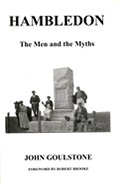 £ 10.00
£ 10.00The Men and the Myths
John Goulstone
Preface by Robert Brooke
A title which finally details the exact history of the Club and its players, from original sources, which is the standard reference work for all to do with Hambledon. Too many of the stories of the Club that have been repeated over the last 100 years have no basis of fact and this publication puts these into their true context. John Goulstone is the historical expert on all forms of sport, with many academic papers published, and is well known in cricket circles for his previous publications on Early Kent Cricket and Early Club and Village Cricket. He famously discovered the portrait of Lumpy Stevens at Knole and was a major contributor to Bowen’s Cricket Quarterly.
Hardback - 220 pages - 16 illustrations - Standard edition
John Lillywhite's Cricketer's Companion 1865
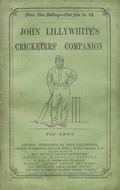 £ SOLD OUT
£ SOLD OUTThis annual was published from 1865 to 1885. Most of these 21 editions are relatively easy to acquire at reasonable prices but the first volume has become almost impossible to find. I am not the only collector who has been unable to find one but, through the good services of Martin Wilson, I am now able to offer a facsimile which will hopefully complete many enthusiasts’ sets. I hope also it may spur collectors and historians who are not familiar with the “Greens”, as they are known, to perhaps start their set with this book.
The Companion provides the link between the three Lillywhite publications. In 1867, Frederick Lillywhite’s Guide was incorporated within its pages, before being absorbed itself by James Lillywhite’s Annual in 1886.
The first edition was published with light green paper wrappers and consists of 160 pages detailing the cricketing highlights of 1864. It contains far more detailed information than Wisden, which was in its second year. This exact facsimile will be available as the original with green boards to protect the wrappers.
Limited to 100 numbered copies.
Henry Bentley's Book of Cricket Matches, including the very rare supplements
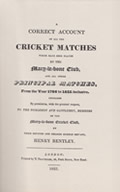 £ 25.00 ONLY FEW LEFT
£ 25.00 ONLY FEW LEFT456 pages approx 200 x 140mm printed on deckle edged 100% cotton mould made 90 gm laid paper, uncut, with facsimile Regency board covers and printed label, with replacement, all as the original book. A superb addition to any library.
Bentley published in 1823 what was then the most complete book of scores and covered the principal matches for the years 1786 to 1822. Subsequently he published two supplements, covering the years 1823 to 1825. The original is very rare and the supplements almost unattainable.
With a 16 page Preface by the leading cricket researcher and writer David Rayvern Allen. This contains much new material on Bentley himself who, besides producing the original books, was a prominent professional cricketer in his day, particularly in Middlesex, Norfolk, Somerset, Hampshire and Herefordshire. He represented England, the Players and the M.C.C. many times and later became a well known umpire. He was also a superb coach and first class groundsman. Numbered Limited Facsimile Edition of 400 Copies

